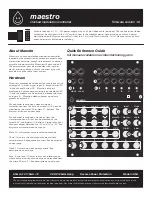
Page 11-35
First, we check the pivot
a
11
. We notice that the element with the largest
absolute value in the first row and first column is the value of
a
31
= 8. Since
we want this number to be the pivot, then we exchange rows 1 and 3, by
using:
1#3L
@RSWP
. The augmented matrix and the permutation
matrix now are:
8 16 -1
41 0 0 1
2 0
3
-1 0 1 0
1 2
3
2 0 0 1
Checking the pivot at position (1,1) we now find that 16 is a better pivot than
8, thus, we perform a column swap as follows:
1#2‚N
@@OK@@
@RSWP
. The augmented matrix and the permutation matrix now are:
16 8
-1
41 0 0 1
0
2
3
-1 1 0 0
2
1
3
2 0 1 0
Now we have the largest possible value in position (1,1), i.e., we performed
full pivoting at (1,1). Next, we proceed to divide by the pivot:
16Y1L
@RCI@
. The permutation matrix does not change, but the
augmented matrix is now:
1 1/2 -1/16
41/16
0 0 1
0 2 3 -1
1 0 0
2 1 3 2
0 1 0
The next step is to eliminate the 2 from position (3,2) by using:
2\#1#3
@RCIJ
1 1/2 -1/16
41/16
0
0 1
0 2 3 -1
1
0 0
0 0 25/8
-25/8
0
1 0
Having filled up with zeros the elements of column 1 below the pivot, now we
proceed to check the pivot at position (2,2). We find that the number 3 in
position (2,3) will be a better pivot, thus, we exchange columns 2 and 3 by
using:
2#3 ‚N
@@@OK@@
1 -1/16 1/2 41/16 0 1 0
















































